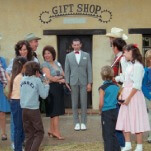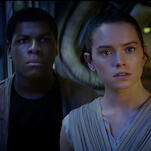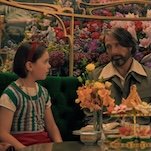Too Many Saints Of Newark: Why the Sopranos movie failed where Deadwood and El Camino films succeeded
From Twin Peaks to The Sopranos, bringing prestige TV to the big screen has never been easy, but some approaches work better than others
Image: Graphic: Natalie Peeples
When The Sopranos cut to black during the show’s 2007 finale, creator David Chase deprived audiences of the closure the episode was building toward. The Man In The Members Only Jacket (Paolo Colandrea) entering the diner, Meadow Soprano (Jamie-Lynn Sigler) struggling to parallel-park her Lexus, “Don’t Stop Believin’” blaring as Tony (James Gandolfini) munched on onion rings—that suspense, gone, all gone. Chase, who directed the final episode and frequently played a heavy hand in the show’s editing, left all threads unresolved on purpose. It was the last chance for viewers to feel what Tony always felt: a menacing suspicion that he could be whacked at any moment. The show ends with an ellipsis, not a period.
Like any good showman, Chase left us wanting more, but on the series he created and The Many Saints Of Newark, its recent spinoff prequel film, desire is a deadly sin. “It’s the wanting,” says Sal Moltisanti (Ray Liotta), reciting his Buddhist philosophy in Many Saints. “All life is pain. Pain comes from always wanting things.” Yet, ironically, the whole film seems to miss that lesson. If only Chase had listened to the Buddhists.
The Many Saints Of Newark is the latest—and most high profile and most expensive—of movie codas to television shows. Unfortunately, it’s also the most divisive. While movies have made for good TV prologues and epilogues for decades, The Many Saints Of Newark is among the most disappointing. After two years of COVID-related delays, the film landed at the box office with a thud. Though it fared better on streaming, Many Saints already feels a bit forgotten. Fans almost immediately returned to posting memes from the original series. At the same time, David Chase went back to press tours about making movies and revealing what became of Tony Soprano after the finale.
Compared to other movie revivals for acclaimed, prestigious television shows, Many Saints falters. The decidedly more low-key El Camino: A Breaking Bad Movie and Deadwood: The Movie prove that some approaches to the growing (or shrinking) pains of going from prestige TV show to tentpole movie work better than others.
Prestige TV grows up and shrinks down
The Golden Age Of TV sustained its years of critical adoration on the promise that these long-form narratives could provide character studies in a way that film could not. Across Breaking Bad’s five seasons, Walter White (Bryan Cranston), for instance, methodically transformed before our eyes from a dying chemistry teacher who gets pushed around by his cop brother-in-law to a fedora-wearing kingpin who gets his brother-in-law killed.
Breaking Bad represented the best of these shows, where season-long arcs created a more profound investment for viewers. That the series ended with many believing its run to be near-perfect is a high wire act achieved by very few.
Adding more story was a risky proposition—one Sal Moltisanti would probably warn against. But, surprisingly, Breaking Bad found the perfect prologue in the spin-off prequel series Better Call Saul. Jumping back into the main storyline, though, creator Vince Gilligan aimed for an epilogue, tying up a loose strand in a way that wouldn’t disturb his original work.
El Camino and the art of being inessential
The one thing all revivals must do is justify their existence. That usually means finding a question the show never answered. Twin Peaks: Fire Walk With Me examined, “What was Laura Palmer like as a person?”; Entourage explored, “Are these guys still rich and horny?” For the epilogue to his series Breaking Bad, El Camino director Vince Gilligan continued a line of thought from his finale script: “From here on, it’s up to us to say where he’s headed,” Gilligan wrote of Pinkman’s (Aaron Paul) escape from captivity. “I like to call it ‘something better’ and leave it at that.” Leave it at that, he didn’t. What happened to Jesse Pinkman after he zoomed to freedom in the show’s finale? El Camino would show us.
To the 2019 film’s benefit, El Camino is essentially inessential. Gilligan’s approach is slight, refusing to disturb the main narrative but homing in on the show’s stylistic quirks and emotional catharsis. Like its source, El Camino is about the process of how one escapes a seemingly impossible situation. While it doesn’t succeed as a standalone movie (one that anyone would watch on a whim without seeing Breaking Bad), it packs enough familiar thrills and faces to make a worthy supplement that could be tucked neatly into the main narrative. One could imagine Jesse’s heist of Todd’s (Jesse Plemons) apartment spread across several episodes, with the reveal of rival thieves, providing several cliffhangers for commercial breaks and episode cappers along the way.
El Camino’s reluctance to take risks ends up helping it. It’s a familiar Breaking Bad story, complete with tense plotting, brutal violence, and propulsive energy. El Camino is both pretty good and also totally inconsequential. It doesn’t pose a big question like, “Who made Tony Soprano?” Instead, it focuses on the immediate escape and conclusion that never felt necessary but is available if fans want it.








































